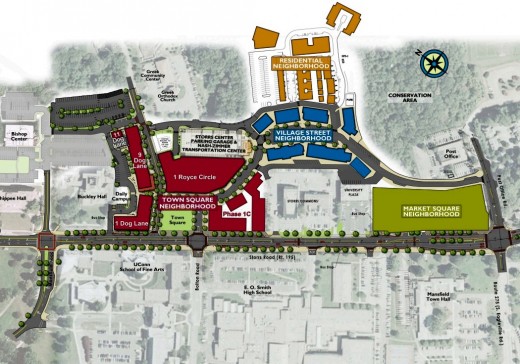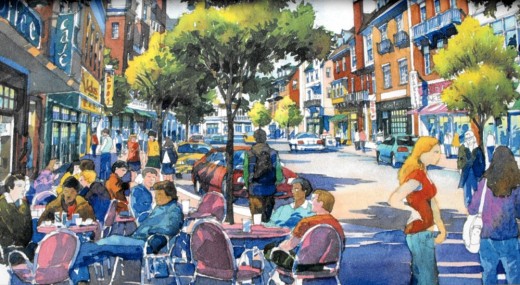Read excerpt from start of this article:
In part I, we discussed what led to interest in developing a downtown center in the university town of Mansfield/Storrs, Connecticut. We continue now with a look at how the town, university, and a private developer worked together to make it happen.
Putting It All Together
For a small town it was a challenge to move forward on the kind of large project both local residents and university officials had in mind. In a community like ours, said Mansfield Town Manager Matthew Hart, “you really need a P3” — that is, a public-private partnership.
A ten-year long planning process ensued. Through economic ups and (more recently) downs, the project slowly moved forward. Public engagement was important — a cause led by the Downtown Partnership and involving many local, citizen-based committees.
The choice for where to locate Storrs Center was clear — adjoining University of Connecticut’s main campus right on Main Street, close to town hall, the community center, and the regional high school. It’s about a 41 acre site, only 17 acres of which will be developed, the remaining 24 acres preserved as open space.

Equally important, most of the project site is on University-owned land — greatly facilitating the project (especially as the Town decided not to use eminent domain to acquire any land — you’ll notice one “gap” along Main Street, where landowners’ decided not to sell their property. The project is simply being designed around this).

But the key event was the Town’s selection of Leyland Alliance as the project developer. Louis Marquet, a principal with Leyland, said his firm was impressed by the strong effort of the Town “to bring the public into this project.” In turn, Leyland staff met with various citizens groups to see how to enhance the vision — “and be realistic about what was achievable on the ground.” As Marquet added, “we were there to implement their vision — in a financially responsible way.”
You must be logged in or a PlannersWeb member to read the rest of the article.